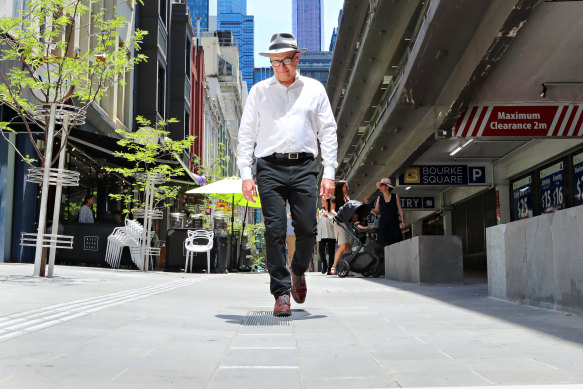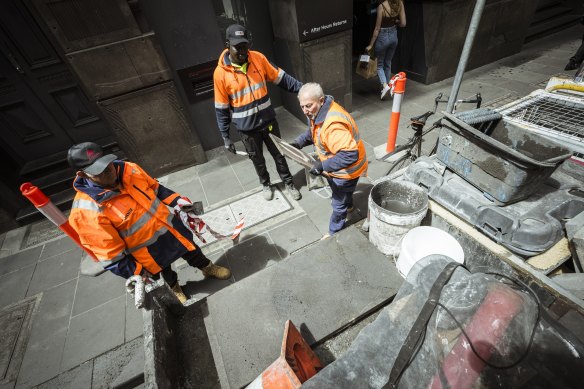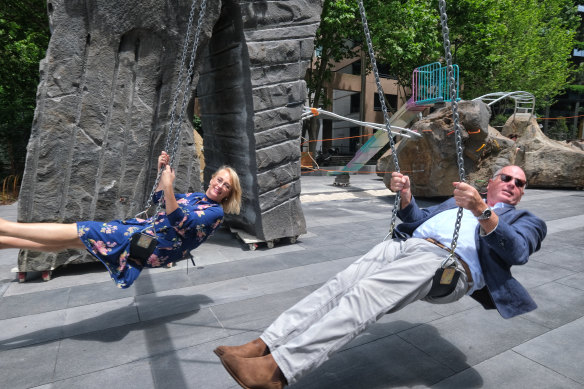
Save articles for later
Add articles to your saved list and come back to them any time.
It’s recognisably Melbourne: slabs of ancient volcanic rock from western Victoria laid in a stretcher bond pattern that thousands of people walk on daily.
Each year, the City of Melbourne spends millions of dollars upgrading the CBD’s footpaths from asphalt to sawn bluestone pavers. So far, more than 83 per cent of the Hoddle grid’s walkways have been converted as part of an effort that started in the 1970s.
Victoria Walks executive officer Ben Rossiter navigates the bluestone tiles on Hardware Lane in Melbourne.Credit: Paul Rovere
But there’s one issue that can’t be tiptoed around. Bluestone has a reputation for being slippery when wet, particularly in sloped areas, and can lead to falls that cause serious injuries including fractures and sprains.
“I would no longer run on bluestone like I would 10 years ago, I have adapted as I get older,” said Victoria Walks executive officer Ben Rossiter.
“Falls in the street are a big issue; once you get over 65 the chance of hospital admissions massively increases.”
The City of Melbourne’s bluestone suppliers are required to meet minimum slip standards under something called the pendulum test, which mimics a shoe striking a wet surface.
Workers laying bluestone pavers in Melbourne’s CBD.Credit: Chris Hopkins
Bluestone in Melbourne is supposed to be at P5, the highest level of slip resistance. However, falls can still happen, with expensive legal action one potential outcome.
The Sunday Age is aware of a case before the Victorian County Court where a 26-year-old man slipped on a bluestone footpath on Elizabeth Street, opposite the H&M store, while it was being cleaned in 2021.
The man’s lawyer, Samantha Mercuri, senior associate from Carbone Lawyers, said the chemical used to wash the bluestone had caused severe chemical burns.
“He required extensive skin grafting and has been left with permanent scarring, disfigurement, and anxiety that this could happen to him or any other member of the public at any time,” she said.
“His life has changed over something that could have very easily been avoided.”
The court action is being contested by the City of Melbourne and its cleaning contractor Spotless, who argue that the man contributed to the damage caused by the fall by failing to watch where he was walking. They also claim the man was intoxicated at the time.
Mercuri said the initiative to replace all of Melbourne’s asphalt footpaths with bluestone pavers could lead to a rise in slips and falls and an increase in public liability claims.
“Although bluestone pavers are aesthetically more appealing on the eye, they do have the potential to increase the risk of injury to the public,” she said.
Lord Mayor Sally Capp (left) says Melbourne’s bluestone footpaths have charm and character. Credit: Luis Enrique Ascui
The City of Melbourne did not comment on the case or how often it faces legal action for slips on bluestone.
Lord Mayor Sally Capp said bluestone pavers had a 50-year lifespan, which was about 10 times that of traditional asphalt surfaces in busy areas.
“Melbourne’s bluestone footpaths are an iconic part of our city’s charm and character – loved by Melburnians and visitors alike,” she said.
“Our footpaths are our city’s largest and most used area of open space – meaning, they must be strong, durable and safe.”
It’s unclear how many people are hurt falling on bluestone footpaths in the city. In 2016, Victoria Walks commissioned research by the Monash University Accident Research Centre that found more than 5000 pedestrians were hospitalised statewide each year after trips and falls.
Injuries to the ankle, foot and head were the most common, with sprains, dislocations and fractures among the likeliest outcomes.
“Bluestone has a lot of benefits. More conventional pavements can be much more susceptible to cracking, raising and trip hazards. We just need to make sure we’ve got the surface right at the correct spots,” said Rossiter.
Those spots include steeper sections of the footpath, such as ramps at intersections where pedestrians cross the road.
Making footpaths as safe as possible was particularly important for those with disabilities, Rossiter said.
While bluestone does have its critics, there’s no doubt it is a striking part of Melbourne’s urban vista. It is expected to take another two decades for the city’s footpaths to be fully converted to bluestone.
“Were not in Amsterdam or other parts of Europe, but when you walk around the bluestone streets at night it almost feels like it,” said Rossiter.
Get the day’s breaking news, entertainment ideas and a long read to enjoy. Sign up to receive our Evening Edition newsletter.
Most Viewed in National
From our partners
Source: Read Full Article


